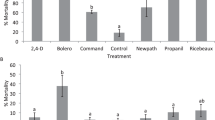Summary
The effects of insect herbivores on natural communities of plants may be demonstrated by manipulative experimetns. Such experiments, which reduce the natural levels of herbivory by application of insecticide, incorporate the assumption that the insecticide has no direct effect on the vegetation. A test of this assumption should therefore be an integral part of any study of herbivory employing chemical exclusion. Here a single compound (Malathion-60), which is commonly used in such studies, is tested both in the field and on selected plant species under controlled conditions. It was found to have no effect on a range of early successional plant species. The limitations of the tests are discussed.
Similar content being viewed by others
References
Allen TC, Casida JE (1951) Criteria for evaluating insecticidal phytoxicity-aerial growth. J Econ Entomol 44:737–740
Boswell VR, Clare WJ, Pepper BB, Taylor CB, Gilmer PM, Carter RC (1955) Effects of certain insecticides in soil on crop plants. US Dept Agric Tech Bull 1121
Bourne BA (1948) Effects of benzene hexachloride on the germination of sugarcane seedlings. Sugar J 10:3–4
Brown VK (1982) The phytophagous insect community and its impact on early successional habitats. In: Visser, JH, Minks AK (eds) Proc 5th Int Symp Insect-Plant Relationships, Wageningen, 1982. Pudoc, Wageningen. pp 205–213
Brown VK (1985) Insect herbivores and plant succession. Oikos 44:17–22
Brown VK, Gange AC, Evans IM, Storr (1987) The effect of insect herbivory on the growth and reproduction of two annual Vicia spp. at different stages in plant succession. J Ecol (in press)
Brown VK, Southwood TRE (1987) Secondary succession: patterns and strategies. In: Crawley MJ, Edwards P, Gray A (eds) Colonisation, Succession and Stability. Blackwells, Oxford (in press)
Brown LC, Cathey GW, Lincoln C (1962) Growth and development of cotton as affected by toxaphene-DDT, methyl parathion, and calcium arsenate. J Econ Entomol 55:398–401
Cantlon JE (1969) The stability of natural populations and their sensitivity to technology. In: Woodwell GM, Smith HH (eds) Diversity and Stability in Ecological Systems. Brookhaven Symp Biol No. 22 pp 197–205
Clements RO (1978) The benefits and some long-term consequences of controlling invertebrates in a perennial ryegrass sward. Proc Symp Grassland Fauna Sci Proc Dublin Soc 6(A):335–341
Clements RO, Henderson IEF (1979) Insects as a cause of botanical change in swards. J Br Grassl Soc, Occ Symp 10:157–60
Fitter AH (1987) Spatial and temporal separation of activity in plant communities: prerequisite or consequence of coexistence. In: Gee JH, Giller PS (eds) Organisation of Communities: Past and Present Symp Brit Ecol Soc (in press)
Fox CJS (1958) Some effects of insecticides on the wireworms and vegetation of grassland in Nova Scotia. Proc 10th Int Cong Entomol (1956) 3:297–300
Gibson CWD, Brown VK, Jepsen M (1987a) Relationships between the effects of insect herbivory and sheep grazing on seasonal changes in an early successional plant community. Oecologia (Berlin) 71:245–253
Gibson CWD, Dawkins HC, Brown VK, Jepsen M (1987b) Spring grazing by sheep: effects on seasonal changes during early old field succession. Vegetatio (in press)
Harper JL (1977) Population Biology of Plants. Academic Press, London
Henderson IF, Clements RO (1977) Grass growth in different parts of England in relation to invertebrate numbers and pesticide treatment. J Br Grassl Soc 32:89–98
Henderson IF, Clements RO (1979) Differential susceptibility to pest damage in agricultural grasses. J Agric Sci, Cambridge 93:465–472
Kinsman S, Platt WJ (1984) The impact of a herbivore upon Mirabilis hirsuta, a fugitive prairie plant. Oecologia (Berlin) 65:2–6
Long WH, Anderson HL, Isa AL, Kyle ML (1967) Sugarcane growth responses to chlordane and microarthropods and effects of chlordane on soil fauna. J Econ Entomol 60:623–629
Louda SM (1982) Limitation of the recruitment of the shrub Haplopappus squarosus (Asteraceae) by flower- and seed-feeding insects. J Ecol 70:43–53
Malone CR (1969) Effects of diazinon contamination on an old-field ecosystem. Amer Midl Natur 82:1–27
Martin H, Worthing CR (1976) Insecticide and Fungicide Handbook. Blackwells, Oxford
McBrien, Harmsen R, Crowder A (1983) A case of insect grazing affecting plant succession. Ecology 64:1035–1039
Morrow PA, LaMarche VC Jr (1978) Tree ring evidence for chronic insect suppression of productivity in subalpine Eucalyptus. Science 201:1244–1246
Parker MA, Salzman AG (1983) Herbivore exclosure and competitor removal effects on juvenile survivorship and growth in the shrub Gutierrezia microcephala. J Ecol 73:905–913
Shure DJ (1971) Insecticide effects on early succession in an old-field ecosystem. Ecology 52:271–279
Southwood TRE, Brown VK, Reader PM (1983) Continuity of vegetation in space and time: a comparison of the insect's habitat templet in different successional stages. Res Popul Ecol Suppl 3:61–74
Southwood TRE, Brown VK, Reader PM (1986) Leaf palatability, life expectancy and herbivore damage. Oecologia (Berlin) 70:544–548
Stinson CSA (1983) Effects of insect herbivores on early successional habitats. Ph.D thesis, University of London
Waloff N, Richards OW (1977) The effect of insect fauna on growth, mortality and natality of broom, Sarothamnus scoparius. Lappl Ecol 14:787–798
Whittaker JB (1982) The effect of grazing by a chrysomelid beetle, Gastrophysa viridula, on growth and survival of Rumex crispus on a shingle bank. J Ecol 70:291–296
Whittaker JB, Warrington S (1985) An experimental field study of different levels of insect herbivory induced by Formica rufa predation on sycamore Acer pseudoplatanus). III. Effects on tree growth. J appl Ecol 22:797–811
Worthing CR, Walker SB (eds) (1986) The Pesticide Manual (8th Ed). The British Crop Protection Council
Author information
Authors and Affiliations
Rights and permissions
About this article
Cite this article
Brown, V.K., Leijn, M. & Stinson, C.S.A. The experimental manipulation of insect herbivore load by the use of an insecticide (malathion): The effect of application on plant growth. Oecologia 72, 377–381 (1987). https://doi.org/10.1007/BF00377567
Received:
Issue Date:
DOI: https://doi.org/10.1007/BF00377567




